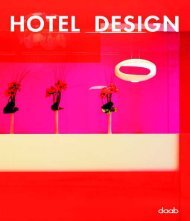You also want an ePaper? Increase the reach of your titles
YUMPU automatically turns print PDFs into web optimized ePapers that Google loves.
––– The spraycan<br />
works best<br />
outside<br />
Interview with<br />
INOPERAbLE<br />
Gallery<br />
The INOPERAbLE Gallery project and Studio was<br />
created in January 2006. After a move in September 2008<br />
to Burggasse 24 in Vienna the gallery established itself as a<br />
young and one-of-a-kind space in the Austrian contemporary<br />
art gallery scene. INOPERAbLE sees itself as much more<br />
connected to the contemporary urban art scene when<br />
compared with the rest of the traditional galleries, and<br />
exhibits on a monthly basis only the best and most original<br />
urban art. Since its conception, the gallery has exhibited<br />
over 100 local and international artists.<br />
–––<br />
The INOPERAbLE gallery was set up in Vienna, Austria,<br />
in 2006. What was your journey from street artist to<br />
gallery owner?<br />
I began doing graffiti when I was about 14 years old.<br />
A friend of mine and I were walking home and a guy was<br />
clearing out his garage and was throwing out a can of<br />
spraypaint. We took it along with some other stuff and went<br />
out that night to cause some mischief. That first can took<br />
me on a long adventure leading to me almost being kicked<br />
out of school, arrested, and looked down upon by many.<br />
8 9<br />
It has also taken me around the world, introduced me to<br />
hundreds of new people and opened me up to the world of art.<br />
I opened the gallery after I finished my studies, I wanted to<br />
contribute something to the community that inspired me<br />
so much. The gallery is my attempt to give something back<br />
to the urban culture. In 2008, Nathalie joined the gallery and<br />
until today,we have been successfully promoting the urban art<br />
movement in Austria.<br />
Street art and graffiti are often influenced by a particular<br />
historical style that is closely related to location, especially<br />
in big cities like New York, London, and Berlin. Please<br />
describe the current general street art styles present in<br />
Vienna and how your graffiti and street art scene has<br />
developed over time.<br />
The early days of graffiti in Vienna were obviously heavily<br />
influenced by cities like New York, but over time cities in<br />
Germany began having a larger impact. Local artists often travel<br />
between the other German-speaking countries and therefore<br />
brought their influences back with them. Being on the border<br />
to the eastern European countries, Vienna has had a big<br />
influence from them as well. A distinct Vienna style in graffiti<br />
and street art is hard to pin down as it has become a melting<br />
pot of styles from all over Europe.<br />
A gallery for urban artists could be recognized as a kind<br />
of white cube concept in that you extract the work from its<br />
origin. How have you found public opinion alters when a<br />
street artist brings his/her work into the gallery space?<br />
The artists we show in the gallery are ARTISTS. Just like<br />
any other artist they create artworks for various purposes.<br />
The difference between “regular” artists and those we exhibit<br />
is that a large percentage of the work created is intended for<br />
outdoors. It is virtually impossible to bring graffiti or street art<br />
one-to-one into a gallery, but the influences, methods, and style<br />
are often carried over when done on a canvas for an exhibition.<br />
Most people understand this, and appreciate the work in the<br />
gallery even if they prefer to see it on the street.<br />
With street works artists often make a political statement.<br />
Do you feel such statements can preserve their status<br />
once transferred into the gallery setting, and signify the<br />
same meaning?<br />
Two of the most famous political street artists are probably<br />
Banksy and Shepard Fairey, but of course there are thousands<br />
of others who are just as significant. Political work in the street<br />
is very strong and can usually have a very heavy impact in a<br />
gallery as well. The artists only need to be careful of becoming<br />
hypocritical. For instance an artist who criticizes the gallery<br />
scene, or a company for inhuman working conditions, and then<br />
does an exhibition or a job for a similar company will very<br />
quickly lose his or her credibility, which to most artists is one<br />
of the most important things one can have.









